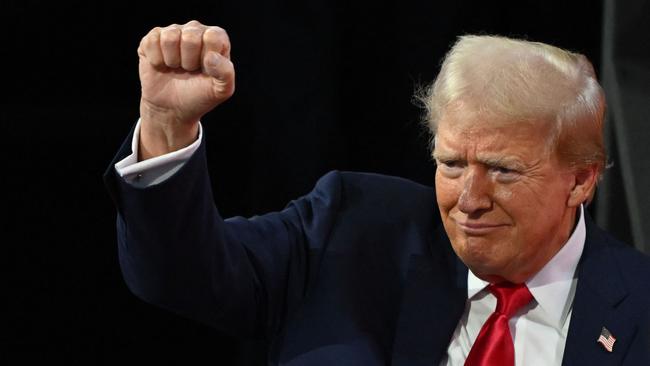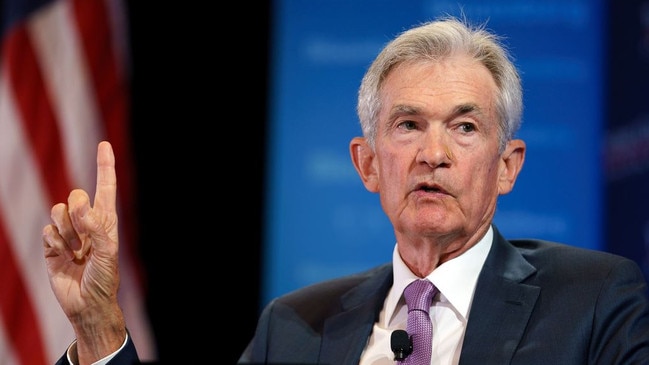This money has now driven spot gold to an “all-time” high, based on non-inflationary adjusted data going back to 1968. Among the biggest buyers are world central banks, which has historians equating their modern day gold storing with the legendary accumulation of gold wealth by King Solomon.
Many central banks are now questioning the safety of holding US dollar- and Euro-denominated assets following regular financial and debt crises (such as Silicon Valley bank) and the war in Ukraine. Instead they fill their reserves with gold.
On the surface, the latest jump in gold is a result of encouraging interest rate remarks from US Federal Reserve chair Jerome Powell, which are also boosting the US sharemarket and which spills over to markets like Australia’s.
And the US sharemarket increase is also being driven by the prospect of higher US earning rates on the back of Donald Trump’s promises of low energy prices, lower taxes. a tariff wall and, of course, the prospect artificial intelligence and other technologies are going to transform the cost structures of many enterprises, including banks.

World inflation will also be helped by the avalanche of low-cost Chinese goods as a result of Xi Jinping’s decision to invest heavily in new factories with robot technology to swamp the world with low-priced goods, including electric cars, appliances and solar and wind power generation equipment.
Leaving aside US tariffs, that’s good for world interest rates.
But, a significant portion of the world’s capital market does not see the outlook this way.
They look at the prospect of a Donald Trump presidency as ushering in an era of much greater world uncertainty, and so they buy gold as a hedge. That’s been a savings pattern for thousands of years, causing gold to serve as a robust store of value since antiquity.
And, of course, in modern times a significant portion of those seeking a risk hedge direct their money to bitcoin and other crypto currencies. This market has a particular appeal to the younger traders who see gold is a relic of the past.
In a strange way gold attracts buyers motivated by contrasting forces. Lower interest rates are attracting buyers but others turn to gold as a defence against a potential stock market sell-off which might be driven by higher interest rates
Among the biggest buyers are those from China who see the yellow metal as a hedge against their local asset values. In Europe there are similar sentiments given the instability in France, the dangers in the UK and the fears a Trump Presidency will see a deal to give Putin a victory in Ukraine, which creates European insecurity. There is also a rising demand for gold jewellery, particularly from India.
On the gold mining side, the years of low gold prices have seen production curbed, so the mining world is unprepared to satisfy this rising demand.
Until recently, mining shares have not matched the rising gold price because of the increasing costs and problems faced by many miners.
Just as the gold mining industry was not prepared to supply the yellow metal required to satisfy the variety of demand-boosting forces, so we will see similar major rises in other metals which find themselves on an increasing demand curve.

The most widely forecast future performer is copper, which participates in most of the emerging electrification strategies.
The world will be watching very carefully to see if Donald Trump sets America on a different direction, but the likelihood is he will simply add cost rationality to energy production so crazy renewal schemes which boost energy costs will be put aside until there is better technology — probably led by the emerging nuclear technologies.
Copper skyrocketed three months ago and then came back, but is still trading at substantially higher levels than at the start of 2024.
We are going to see major global investment in gold, copper, lithium and other minerals to meet demand in the current environment.
But, the capital available to undertake these investments is limited and it will need to compete with the substantial investment required to re-equip industry to use automated procedures and, of course, artificial intelligence.
The grave risk in Australia is our industrial relations laws will take us back to the 1950s and 1960s and will prevent the nation participating in this new round of investment as the world competes for capital.
An investment boom is good for stock markets and gold is there as a hedge should the complexities of current changes and the military, social and other potential dangers emerging around the world prevent this transformation being realised in the way sharemarkets are beginning to expect.






The global gold bulls are celebrating as a series of forces around the world drives big money into the yellow metal.